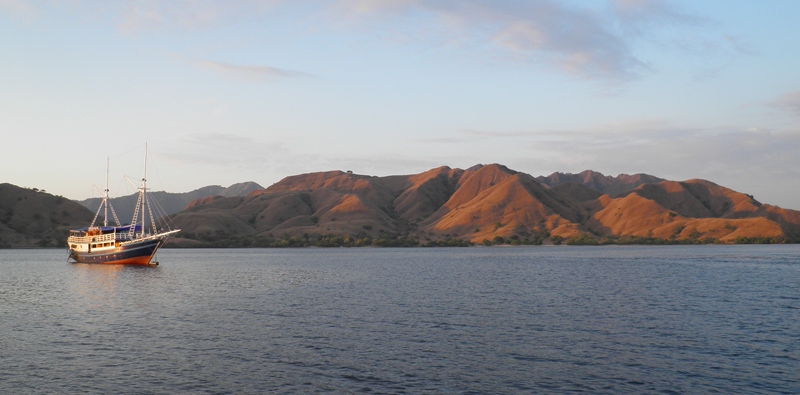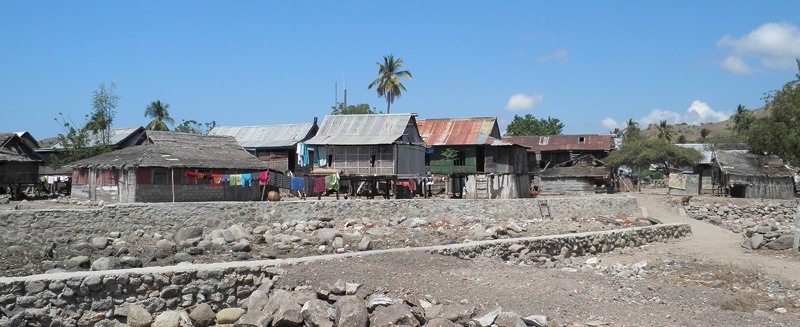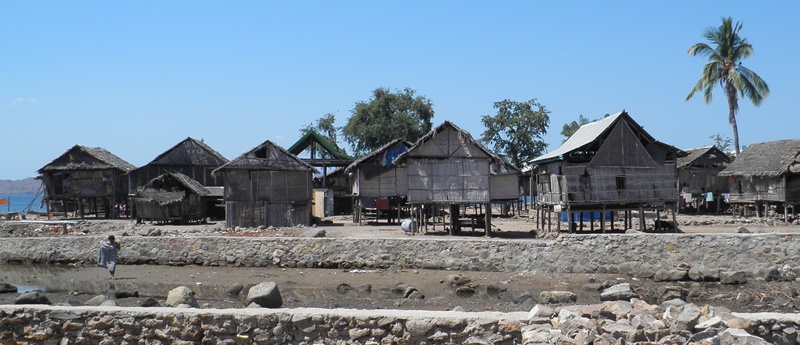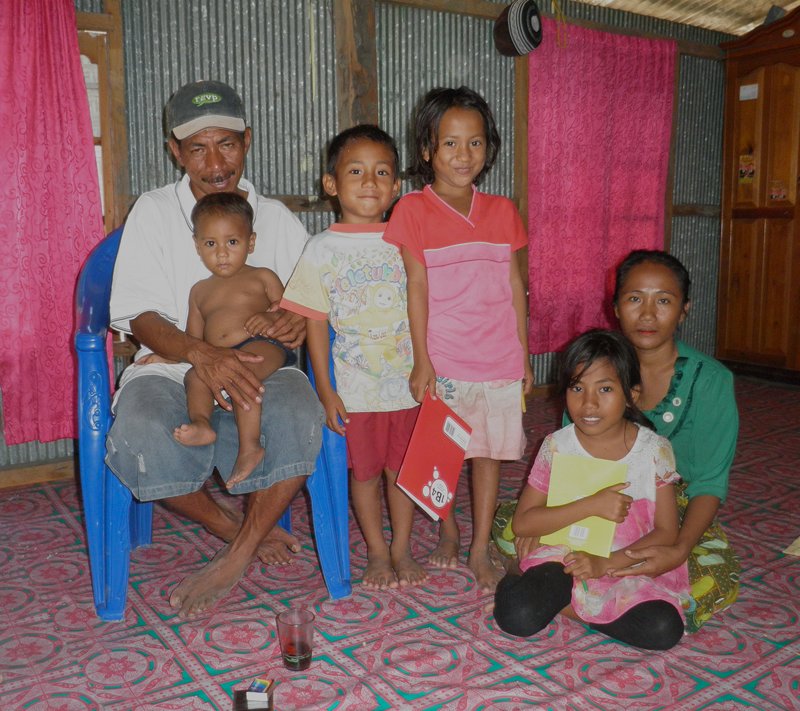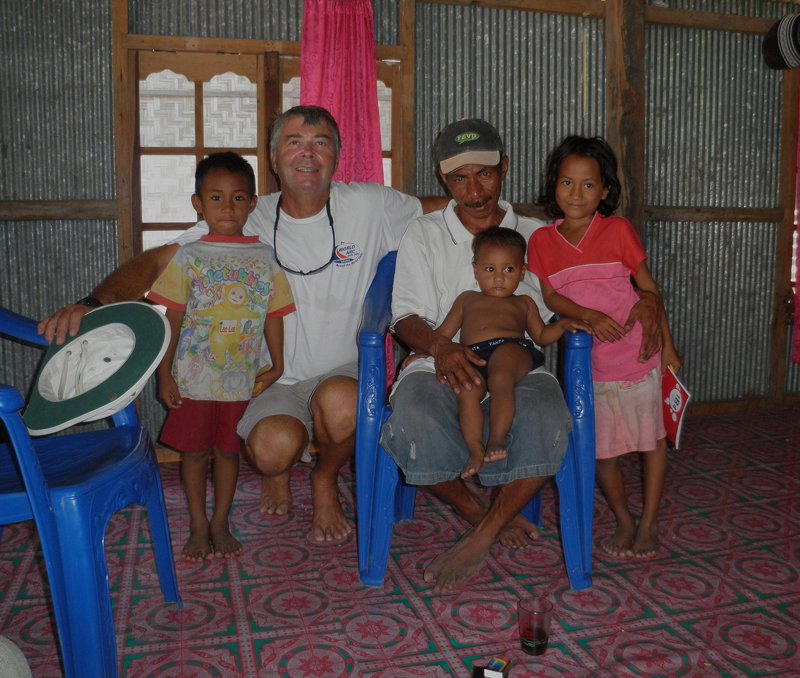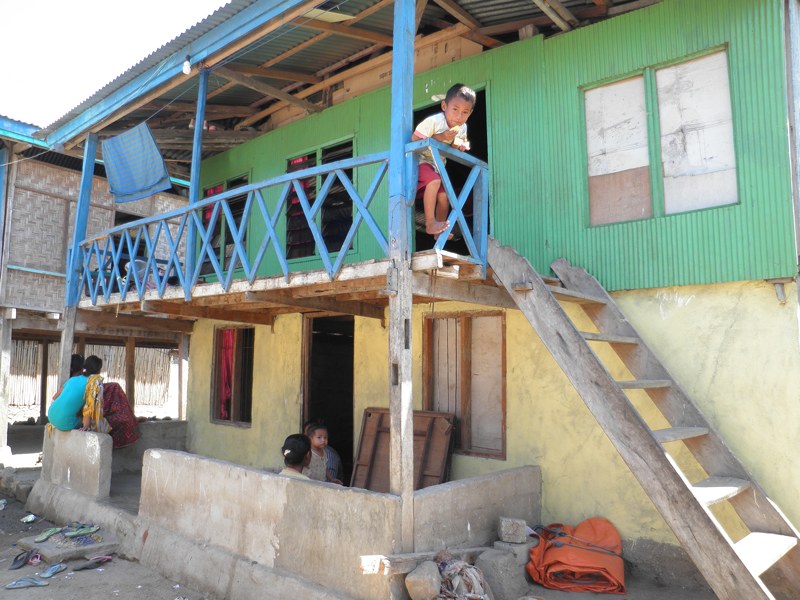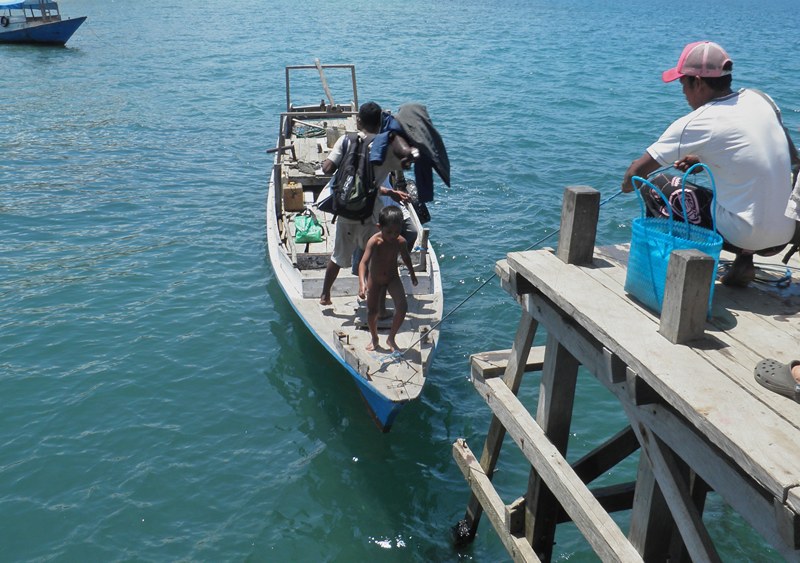Komodo Village and Putt-Putt Adventures - Punja Island, Komodo National Park, Indonesia

Harmonie
Don and Anne Myers
Sun 5 Sep 2010 21:24
|
08:36.364S 119:31.472E
On August 31st we left Rinca Island and motored
three hours in zero wind through more water
swirling between more arid, barren, yet beautiful islands full of
craggy russet mountain peaks, to tiny Punja Island off the coast of big Komodo
Island in the heart of Komodo National Park. The park and all its dry
islands lie to the northwest of soaring Flores Island, so any moisture traveling
on the southeast trade winds dumps on Flores before it reaches the Komodo
area. Komodo is one of the driest areas in Indonesia, and Flores Island,
only a few miles to the southeast is covered in rainforest.
Funny how that works.
Picture 1 - The spot we chose to anchor is a
favorite of the live-aboard dive tourist boats, and this is one of them moored
just behind us at sunset. The mountains around here are dry, but make a
perfect backdrop for boats at anchor, particularly at sunset.
Picture 2 - Another day, another set of boat boys
and another putt-putt trip. This time it was Arti, his crew of two and a
trip to Komodo Village, where all the local boat boys hail from. Next to
Don is Dor, and in the back is the driver whose name escapes me. Arti is
perched up front out of sight of the camera.
Pictures 3 and 4 - Komodo Village.
Home of 1,163 people. Granted, these pictures are of the portion of
the village that exists on the other side of the tracks, or in this case, on the
other side of the inlet, so the homes look rather grim, but even the homes on
the right side of the tracks struggled to make themselves presentable.
This is probably the most desperate village we've seen so far. And
understandably so. The dry-as-a-bone soil yields no crops, all the
village's staple foods are brought in from Labuan Bajo. The men
of the village either carve Komodo dragons out of wood from hibiscus
trees, or they sell them. There doesn't seem to be any other occupation or
source of income for the village. There was a large collection of wooden
fishing boat contraptions along the beach, but when we asked Arti if there were
a lot of fishermen in the village, he indicated that many of the men used to
fish, but are now "business men" like him (meaning boat boys). This
appeared to be true because soon after we dropped anchor by Punja Island,
which is only about two miles from Komodo Village, a wooden fishing boat
contraption (a putt-putt boat base, but with what looks like a scaffold of tree
limbs sticking out on both sides presumably used to support fishing nets)
dropped anchor nearby. We watched, amazed, as the
young local floated a foot-thick square of polystyrene foam next to
his contraption, and proceeded to load a few things onto it as well as
himself. "Ah!" exclaimed Don "It's his dinghy!" Yup, what we
thought was a fisherman approaching to sell us his day's catch, was
actually a boat boy in disguise, floating over on his foam slab dinghy to sell
us Komodo dragon teeth necklaces and wood carvings. Regardless of what it
is now, the village must have originally developed based on fishing. We
can't think of any other reason why people would settle in this parched
place.
Picture 5 - Arti and his family in his
home. After scouring the village for vegetables to buy (we found some
cabbage and tomatoes, and even though we're sure we paid a good price, we
couldn't help feeling like we were taking food away from some poor
villager's table), Arti invited us to his home for coffee. Arti and the
other boat boys we've met seem to practice a modified version of Islam, which
allows them to eat and drink in daylight during Ramadan. We did
notice that the curtains were closed to prying eyes when the coffee was served
though. Arti has four children, all shown in picture
5 along with his wife. The kids are clutching the notebooks and
colored pencils we gave to them - all received with a higher than
expected level of excitement. As always happens when we give stuff
away, one little cousin asked us where her notebook and colored pencil
were as we walked away from Arti's home. We had nothing left to give
her, leaving her to follow hopefully behind as we walked back to the
putt-putt at the wharf. There's never enough for everyone and we hate to
set the expectation for the villagers that we boaters will provide for
them. It's an unrealistic and probably unhealthy expectation, but the
problem lies in where to draw the line. We hate to be cold-hearted, but we
also don't want to promote begging, which is usually what happens when villagers
expect boaters (or any other visitors) to show up and give them things for
nothing in return. At least in the case of the boat boys, we give them
money in return for trinkets, putt-putt rides and guide services.
Picture 6 - Don with Arti and three of his
kids.
Picture 7 - Arti's house. One of the nicer
homes in the village, it is an upstairs/downstairs affair with the formal living
room and two smaller rooms upstairs. We were served coffee in the
living room, which is a wide open space with no furniture except for one china
cabinet holding perfectly stacked and arranged bowls and dishes, and one small
wardrobe for clothes, both pushed up against the wall in a corner. The
wide expanse of the floor was covered in a garish pink linoleum and the windows
covered with matching pink curtains. The floor was bouncy when even Arti's
small son walked around. Generally, it wasn't a place you would want to be
in a earthquake, but the plastic chairs and slight breeze blowing through the
real glass windows made for a not unpleasant atmosphere. The coffee was
strong, extremely sweet and care had to be taken not to end up with a mouthful
of grounds. A good experience all and all.
Picture 8 - When we got back to the putt-putt at
the wharf, this little naked guy emerged from below deck where he had been
pumping the water out of the bilge to keep the boat afloat. Usually we see
little naked guys bailing the water out of wooden canoes, but
this was the first time we saw a putt-putt bilge pumping little naked
guy.
Our boat was a little over two miles from the
village, and when we got to within about a half mile of it, the putt-putt's
engine went kaput. Our three boat boys immediately attended to the engine
with rusted wrenches in hand while Don and I envisioned the headlines, "Two
American Sailors Lost at Sea off Komodo Island! Twenty Komodo Dragon
Carvings Recovered. No Other Survivors Found!" Luckily, the
putt-putt putted back to life and we lived to tell the story.
Anne
|
